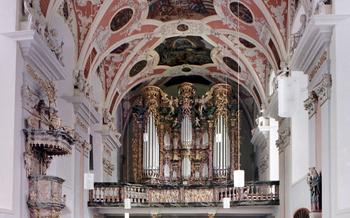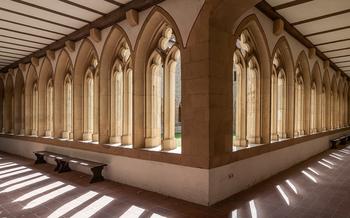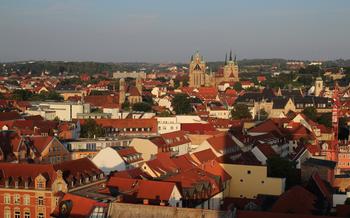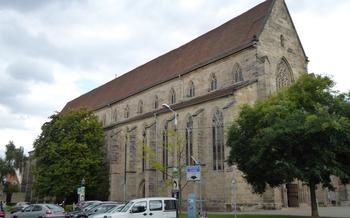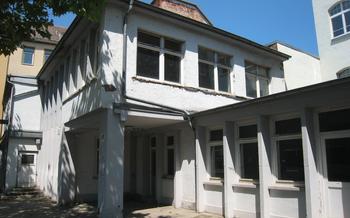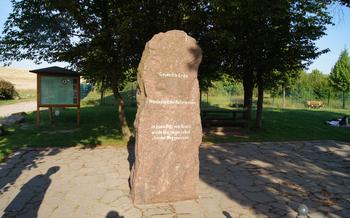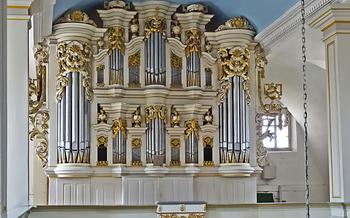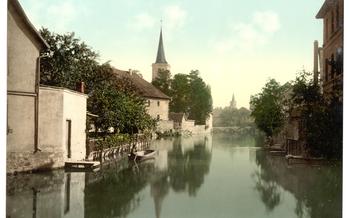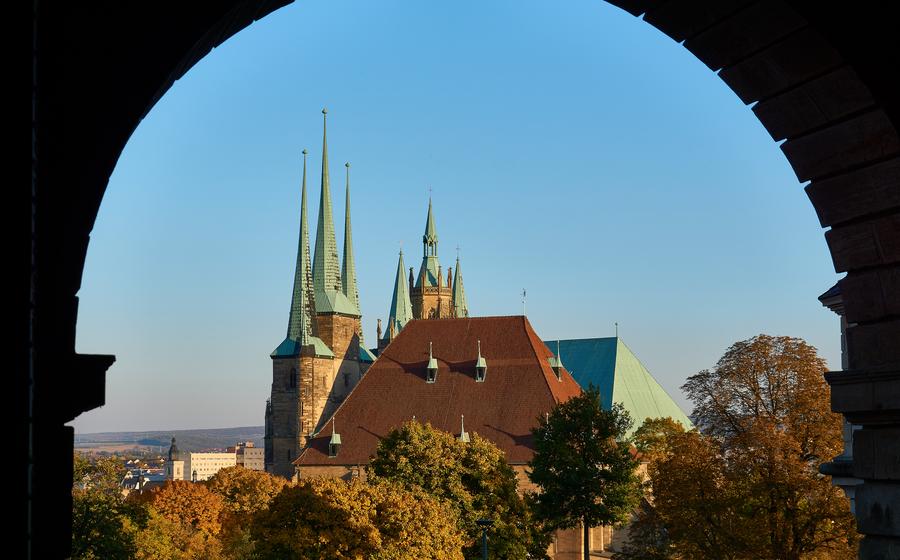
Erfurt Cathedral (Erfurter Dom)
- Erfurter Dom: Symbol of Architectural Mastery
- A Journey Through Time: The Cathedral's History
- Exploring the Cathedral's Interior: A Realm of Art and Grandeur
- The Glories of Gothic Architecture: Erfurt Cathedral as an Exemplar
- Saint Mary's Bell: A Symbol of Hope and Resilience
- The Treasury: Unveiling Hidden Treasures
- The Erfurt Cathedral Ensemble: A Tapestry of Architectural Wonders
- Religious Significance: A Center of Faith and Pilgrimage
- Cultural Events and Exhibitions: A Vibrant Venue for Artistic Expression
- Guided Tours: Unveiling the Cathedral's Secrets
- Accessibility and Visitor Information
- Erfurt's Rich History Reflected in the Cathedral
- Erfurt Cathedral Square: A Place of Gathering and Celebration
- Erfurt's Other Architectural Gems: Exploring the City's Treasures
- Insider Tip: Unveiling a Hidden Gem
Erfurter Dom: Symbol of Architectural Mastery
The Erfurt Cathedral, or Erfurter Dom, stands as a testament to the architectural prowess and cultural significance of the city of Erfurt. With its towering spires reaching towards the heavens, the cathedral is a masterpiece of Gothic architecture, boasting unique features that set it apart from its contemporaries. Its historical importance as a place of worship, pilgrimage, and cultural exchange has made it an enduring symbol of Erfurt's rich heritage. The intricate details, harmonious proportions, and spiritual aura of the Erfurt Cathedral make it a must-visit destination for travelers seeking to immerse themselves in the architectural wonders of Germany.
A Journey Through Time: The Cathedral's History
The Erfurt Cathedral, a testament to the city's rich history, stands as a symbol of architectural mastery and spiritual significance. Its origins can be traced back to the 8th century, when the first Christian church was built on the site. Over the centuries, the cathedral underwent several transformations, reflecting the changing religious and political landscape of Erfurt.
In the 12th century, the Romanesque basilica was replaced by a larger Gothic structure, which forms the core of the present cathedral. This period marked a significant turning point in the cathedral's history, as it embraced the Gothic architectural style that would shape its iconic appearance.
The cathedral's construction progressed throughout the 13th and 14th centuries, with the addition of the nave, choir, and transepts. During this time, the cathedral became a prominent center of religious and cultural activity, attracting pilgrims and visitors from across the region.
In the 16th century, the Reformation brought about significant changes to the cathedral. The interior was stripped of its Catholic imagery, and the cathedral became a Lutheran church. Despite these changes, the cathedral's architectural integrity remained intact, preserving its Gothic grandeur.
Throughout the centuries, the cathedral has undergone several renovations and restorations, ensuring its preservation for future generations. In the 19th century, extensive restoration work was carried out under the direction of the renowned architect Friedrich August Stüler, who restored the cathedral to its former glory, showcasing its architectural magnificence.
Today, the Erfurt Cathedral stands as a testament to the city's rich history, embodying the architectural and spiritual heritage of Erfurt. It continues to be a place of worship, pilgrimage, and cultural significance, attracting visitors from around the world who come to admire its beauty and delve into its captivating history.
Exploring the Cathedral's Interior: A Realm of Art and Grandeur
The interior of Erfurt Cathedral is a testament to the artistry and devotion of its creators. Sunlight floods through the magnificent stained glass windows, casting a kaleidoscope of colors onto the grand nave. These windows, adorned with intricate biblical scenes, tell stories of faith, hope, and redemption. Each window is a masterpiece, a testament to the skill and devotion of the medieval artisans who crafted them.
Intricate sculptures grace the cathedral's walls and columns, depicting saints, angels, and biblical figures. Every detail is meticulously rendered, every expression carefully etched in stone. These sculptures are not mere decorations; they are powerful symbols of faith, reminders of the divine presence that permeates the cathedral.
Majestic altars, each a work of art in its own right, adorn the cathedral's interior. The high altar, a masterpiece of Gothic craftsmanship, is a testament to the skill and artistry of the medieval stonemasons. Its intricate carvings, delicate tracery, and shimmering gold leaf create a sense of awe and wonder. The side altars, though smaller in scale, are equally impressive, each with its unique design and iconography.
The nave, with its soaring heights and graceful arches, is a breathtaking sight. The slender columns, reaching towards the heavens, create a sense of awe and wonder. The intricate rib vaulting, with its geometric patterns and delicate tracery, is a marvel of engineering and artistry. The overall effect is one of grandeur and majesty, a fitting tribute to the divine.
The Glories of Gothic Architecture: Erfurt Cathedral as an Exemplar
The Erfurt Cathedral is a prime example of Gothic architecture, showcasing its distinctive features and structural innovations. The soaring spires, pointed arches, and ribbed vaults create a sense of verticality and grandeur, drawing the eyes upward towards the heavens. The intricate tracery of the windows allows for an abundance of natural light to flood the interior, illuminating the vibrant stained glass and creating a kaleidoscope of colors. The flying buttresses, a hallmark of Gothic architecture, provide structural support while adding a sense of lightness and elegance to the cathedral's exterior. The interplay of light and shadow within the cathedral's vast interior creates a mystical and awe-inspiring atmosphere, enhancing the spiritual experience of visitors.
The Erfurt Cathedral's Gothic design is comparable to other notable cathedrals of the period, such as the Cologne Cathedral and the Amiens Cathedral. While each cathedral has its own unique characteristics, they share a common thread of Gothic architectural principles and aesthetics. The Erfurt Cathedral holds its own among these architectural masterpieces, demonstrating the skill and ingenuity of medieval builders and the enduring legacy of Gothic architecture.
Saint Mary's Bell: A Symbol of Hope and Resilience
Among the treasures of the Erfurt Cathedral, the Saint Mary's Bell stands as a symbol of hope and resilience. Cast in 1497 by the renowned bell founder Hans Heyn, the bell bears the image of the Virgin Mary, a testament to its dedication to the city's patron saint. Over the centuries, the bell has played a vital role in Erfurt's history, ringing out to mark significant events and providing solace during times of hardship.
The bell's deep, resonant sound has echoed through Erfurt's streets for over 500 years, calling the faithful to prayer, signaling the start of festivals, and warning of approaching danger. During the tumultuous periods of the Reformation and the Thirty Years' War, the bell served as a beacon of hope, reminding the people of Erfurt of their shared faith and resilience. It was during this time that the bell earned its nickname, "Maria Gloriosa", a testament to its enduring significance.
In 1813, as Napoleon's army approached Erfurt, the bell was hastily taken down from the cathedral tower and hidden in a nearby village to prevent it from being melted down for cannons. This act of defiance and preservation ensured that the bell would continue to ring out over Erfurt for generations to come.
Today, the Saint Mary's Bell remains a beloved symbol of Erfurt's rich history and cultural heritage. Its sound continues to resonate through the city, reminding the people of Erfurt of their shared past and inspiring them to face the future with hope and resilience.
The Treasury: Unveiling Hidden Treasures
Within the hallowed halls of the Erfurt Cathedral lies a hidden treasure trove of immense historical and religious significance: its treasury. Here, visitors can embark on a journey through time, discovering artifacts that narrate the cathedral's rich past and its profound impact on the spiritual and cultural landscape of the region.
Among the treasury's prized possessions are precious relics, each imbued with stories of faith, devotion, and divine intervention. These relics, including fragments of saints' bones, intricate reliquaries, and ornate vessels, offer a glimpse into the deep reverence and piety that have permeated the cathedral's walls for centuries.
The treasury also houses a remarkable collection of ecclesiastical treasures, showcasing the exceptional craftsmanship and artistry that have adorned the cathedral's rituals and ceremonies. From intricately crafted chalices and ciboria to resplendent vestments and jewelry, these artifacts bear witness to the devotion and opulence that have characterized the cathedral's religious traditions.
Beyond its historical and religious significance, the treasury plays a crucial role in preserving and showcasing the cultural heritage of Erfurt. Through guided tours and interactive exhibits, visitors can delve into the stories behind these precious artifacts, gaining insights into the lives of the people who created and used them.
The treasury is a testament to the enduring legacy of the Erfurt Cathedral, a place where faith, history, and artistry converge. It invites visitors to explore the depths of its hidden treasures, revealing the profound spiritual and cultural significance that lies within its walls.
The Erfurt Cathedral Ensemble: A Tapestry of Architectural Wonders
The Erfurt Cathedral Ensemble is not merely a collection of structures; it is a harmonious symphony of architectural styles that together narrate the city's rich history. The cathedral stands as the centerpiece, its Gothic grandeur complemented by the Romanesque architecture of St. Severus Church, the Renaissance charm of the Old Town Hall, and the Baroque elegance of the Collegium Maius.
Each building within the ensemble possesses its own unique character, yet they blend seamlessly to create a cohesive masterpiece. The Old Town Hall, with its intricate carvings and colorful facade, adds a touch of playfulness to the ensemble's otherwise solemn demeanor. Meanwhile, the Collegium Maius, with its graceful arches and airy courtyard, exudes an air of scholarly refinement.
Together, these architectural wonders form a tapestry that tells the story of Erfurt's transformation over the centuries. They represent different eras, styles, and influences, but they are united by a common thread of artistry and craftsmanship. The ensemble is a testament to the city's enduring spirit and its commitment to preserving its architectural heritage.
Strolling through the Erfurt Cathedral Ensemble is like embarking on a journey through time. The buildings whisper tales of medieval merchants, Renaissance scholars, and Baroque princes, all of whom left their mark on the city's architectural landscape. It is a place where history comes alive, where the past and present intertwine, creating a captivating urban tapestry.
Religious Significance: A Center of Faith and Pilgrimage
The Erfurt Cathedral stands as a beacon of faith and spirituality, drawing pilgrims and worshippers from across the region. Its hallowed halls have witnessed countless religious ceremonies, prayers, and expressions of devotion throughout the centuries. As a center of the local religious community, the cathedral plays a vital role in fostering spiritual growth and strengthening the bonds of faith among its congregation.
The cathedral's significance extends beyond its physical presence; it represents the city's spiritual identity and serves as a symbol of hope and solace for the people of Erfurt. Major religious events and festivals are held within its walls, bringing together believers from all walks of life to celebrate their shared faith. These gatherings create a powerful sense of unity and belonging, reinforcing the cathedral's role as a spiritual hub for the community.
Cultural Events and Exhibitions: A Vibrant Venue for Artistic Expression
The Erfurt Cathedral is not merely a place of worship but also a vibrant venue for cultural events and exhibitions. The cathedral's majestic interiors provide a unique and awe-inspiring backdrop for concerts, art exhibitions, and other cultural events. The fusion of art, music, and spirituality within the cathedral's walls creates an unforgettable experience for visitors.
The cathedral collaborates with local artists and performers to showcase their talents and share their creative expressions with the community. From classical concerts featuring renowned musicians to contemporary art exhibitions highlighting local artists, the cathedral offers a diverse range of cultural events throughout the year.
These events not only enrich the spiritual experience of visitors but also contribute to Erfurt's vibrant cultural landscape. The cathedral's commitment to promoting art and culture reflects its dedication to fostering a sense of community and creating a space for artistic expression and appreciation.
Guided Tours: Unveiling the Cathedral's Secrets
Embark on a journey through time and unravel the captivating stories behind the Erfurt Cathedral's majestic walls with the guidance of expert tour leaders. These knowledgeable guides, passionate about the cathedral's history and architecture, will lead you on an immersive exploration, revealing the hidden secrets and fascinating tales that lie within.
Choose from a variety of themed tours tailored to your interests, whether you seek an in-depth understanding of the cathedral's Gothic architecture, the significance of its religious relics, or the role it has played in Erfurt's rich history. Specialized itineraries cater to diverse preferences, ensuring a personalized and enriching experience for every visitor.
For those with limited mobility, accessibility options are available to ensure that everyone can fully participate in the guided tours. Ramps, elevators, and designated seating areas allow visitors with disabilities to comfortably navigate the cathedral's spaces and enjoy the tour's insights.
Don't miss this opportunity to delve deeper into the Erfurt Cathedral's captivating narrative and gain a profound appreciation for its architectural wonders and cultural significance. Let the knowledgeable guides be your companions as you unlock the secrets of this awe-inspiring masterpiece.
Accessibility and Visitor Information
-
Opening Hours and Admission Fees: The Erfurt Cathedral is open to visitors daily, with varying hours for summer and winter seasons. Admission to the cathedral is free of charge, allowing visitors to explore its grandeur without any financial constraints.
-
Accessibility for Visitors with Disabilities: The Erfurt Cathedral is committed to providing an accessible and inclusive environment for all visitors. Wheelchair ramps and elevators ensure that individuals with mobility challenges can easily navigate the cathedral's interior. Additionally, guided tours designed for visitors with visual or hearing impairments are available upon request.
-
Visitor Center and Its Services: A visitor center located adjacent to the cathedral serves as a valuable resource for tourists. Here, visitors can obtain comprehensive information about the cathedral's history, architecture, and ongoing events. Friendly and knowledgeable staff is available to assist with inquiries, provide guided tours, and offer recommendations for exploring the city.
-
Contact Information and Online Resources: For those seeking more information or planning their visit in advance, the Erfurt Cathedral's official website provides detailed information about opening hours, events, accessibility options, and contact details. Visitors can also connect with the cathedral through social media platforms for updates on special events, exhibitions, and guided tours.
Erfurt's Rich History Reflected in the Cathedral
The Erfurt Cathedral stands as a testament to the city's rich and storied past. It has witnessed the rise and fall of empires, religious upheavals, and the transformation of Erfurt into a thriving cultural and economic center. The cathedral's walls hold the secrets of bygone eras, echoing with the footsteps of pilgrims, rulers, and ordinary citizens who have sought solace, guidance, and inspiration within its sacred space.
Throughout the centuries, the cathedral has undergone several renovations and expansions, reflecting the changing architectural styles and the evolving needs of the community. It has survived wars, fires, and political turmoil, emerging as a symbol of resilience and continuity. The cathedral's ability to adapt and endure mirrors Erfurt's own journey through history, showcasing its capacity for reinvention and renewal.
As a cultural and historical landmark, the Erfurt Cathedral embodies the spirit of Erfurt and its people. It is a tangible link to the city's past, a reminder of the struggles and triumphs that have shaped its identity. By exploring the cathedral, visitors can gain a deeper understanding of Erfurt's rich history and the enduring legacy of its architectural masterpiece.
Erfurt Cathedral Square: A Place of Gathering and Celebration
The Erfurt Cathedral Square, also known as Domplatz, is a vibrant and historic space that surrounds the Erfurt Cathedral. Over the centuries, this square has served as a gathering place for both religious and secular events, witnessing significant moments in Erfurt's history.
The square is adorned with several architectural highlights, including the Cathedral itself, the Gothic-style Town Hall, and the Renaissance-era Krämerbrücke, a unique bridge lined with colorful half-timbered houses. The square's cobblestone pavement adds to its charm, creating an ambiance that transports visitors back in time.
Historically, the square has been a hub for markets, festivals, and public gatherings. In the Middle Ages, it was the site of jousting tournaments and trade fairs. Today, it continues to host a variety of events, including the annual Christmas market, concerts, and cultural festivals.
The square's significance extends beyond its historical and architectural value. It serves as a meeting point for locals and a gathering place for community events. Its lively atmosphere, coupled with the stunning backdrop of the cathedral and surrounding buildings, makes it a popular destination for both residents and visitors alike.
Whether you're attending a festival, admiring the architecture, or simply soaking up the atmosphere, Erfurt Cathedral Square offers a unique and memorable experience. It's a place where history comes alive, and the spirit of Erfurt's rich heritage can be felt in every corner.
Erfurt's Other Architectural Gems: Exploring the City's Treasures
Beyond the awe-inspiring Erfurt Cathedral, the city boasts a treasure trove of architectural wonders that captivate visitors with their unique charm and historical significance. Wander through the picturesque streets and discover a harmonious blend of architectural styles, from Gothic to Renaissance and Baroque. Explore the majestic churches, such as the Predigerkirche with its stunning stained glass windows, or the Augustinian Monastery, where Martin Luther once resided. Marvel at the intricate facades of the Merchants' Bridge and the Rathaus, symbols of Erfurt's rich trading past. Don't miss the Krämerbrücke, a unique bridge lined with half-timbered houses, offering a glimpse into medieval life. With its abundance of architectural gems, Erfurt is a paradise for history and architecture enthusiasts, inviting you on a fascinating journey through time.
Insider Tip: Unveiling a Hidden Gem
Beyond the grandeur of the Erfurt Cathedral itself, visitors should take a moment to explore the intricate details of the surrounding cloister. Step into the serene courtyard, where ancient arches and delicate tracery create a picturesque backdrop. Admire the beautifully preserved capitals that adorn the columns, each one a testament to the skill and artistry of medieval craftsmen. Discover hidden corners and secluded nooks, where time seems to stand still, and the echoes of centuries past linger in the air. In the cloister's peaceful embrace, visitors can find a moment of tranquility and reflection, away from the bustling city streets.
